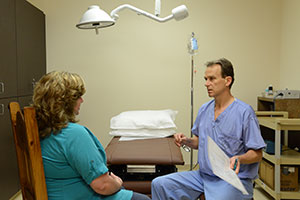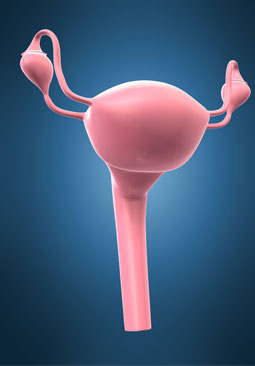F emale Urology emale Urology
Select from the following topics to learn more about common Female Urology Conditions.
Anterior repair (colporrhaphy)
Even though the anterior repair is the most commonly utilized operation for correction of a cystocele, anterior repair is probably not the most effective, nor is it the correct operation for restoring a woman's anatomy and maintaining vaginal length and function. The problem with using anterior repair operation in young healthy sexually active woman with a paravaginal defect (cystocele) is the surgeon does not really surgically support the bladder, but instead reduces the bulge by "scrunching" the fascia under the bladder together.
Click here to read more.
Exercising Your Pelvic Muscles
Life's events can weaken pelvic muscles. Pregnancy, childbirth and being overweight can do it. Luckily, when these muscles get weak, you can help make them strong again.
Pelvic floor muscles are just like other muscles. Exercise can make them stronger. Women with bladder control problems can regain control through pelvic muscle exercises, also called Kegel exercises. 
Click here to read more.
[Top]
The Vaccine For HPV Infections in Women
Human papillomavirus (HPV) causes one of the most common sexually transmitted diseases (STD). HPV can infect the genital area of men and women including the skin of the penis, the vagina, cervix, or rectum. Most people who become infected with HPV will not have any symptoms. Some of these viruses may cause abnormal PAP tests and may also lead to cancer of the cervix. This article will discuss the incidence, diagnosis, and treatment of HPV.
Click here to read more.
HPV or Human papillomavirus
Genital HPV infection is a sexually transmitted disease (STD) that is caused by human papillomavirus (HPV). Human papillomavirus is the name of a group of viruses that includes more than 100 different strains or types. More than 30 of these viruses are sexually transmitted, and they can infect the genital area of men and women including the skin of the penis, vulva (area outside the vagina), or anus, and the linings of the vagina, cervix, or rectum. Most people who become infected with HPV will not have any symptoms and will clear the infection on their own.
Click here to read more.
Hypoactive Sexual Desire Disorder
Hypoactive Sexual Desire Disorder is a lack of sexual desire that causes a woman personal distress. This includes a persistent or recurring deficiency or absence of sexual fantasies or thoughts, or a lack of interest in sex or being sexual. Often women suffering with this complaint will report they feel "flat" sexually or sexually "dead".
Click here to read more.
Interstitial cystitis: When urgency and frequency mean more than routine inflammation
Abstract: Although it's not a malignant or infectious condition, interstitial cystitis can be as disabling and sometimes even more difficult to manage. Many women undergo ineffective gynecologic surgery, and some men have inappropriate transurethral prostatectomy in a desperate attempt to subdue their pain. The authors provide tips for primary care physicians on making a presumptive diagnosis and suggest symptomatic relief methods to try before referral.
Click here to read more. [Top]
Pelvic Organ Prolapse / Vaginal Prolapse Overview 
Throughout a lifetime, women's bodies undergo tremendous stress, including pregnancy, childbirth, strenuous exercise, and gynecologic surgeries. All of these stresses—accumulated over the years—can weaken the natural support structure of the pelvis, which can cause the pelvic organs to shift from their natural, intended position and/or to protrude into or outside of the vaginal canal. It's actually not an uncommon problem, and it can affect women of many ages and health circumstances.
Click here to read more.
[Top]
Raising Up the Dropped Bladder
There are nearly 14 million American women who suffer from urinary incontinence or the involuntary loss of urine. One of the most common causes is a dropped bladder. Dropped bladder is a general term to describe a condition known as Pelvic Organ Prolapse (POP). POP means that one of the pelvic organs - the bladder, the uterus, the intestines or the rectum has fallen down into the vagina. POP ranges in severity from very mild (i.e. prolapse that can only be felt by your doctor on examination) to severe where one or more of the pelvic organs actually protrude through the vaginal opening and can be easily felt by the woman on self examination. When the POP is severe you can actually see it; it looks like a red ball protruding from the vagina.
Click here to read more.
Self Care for Women With Urinary Incontinence
Incontinence is a condition that results in the involuntary loss of urine without the owners' permission. It is a condition that affects millions of American men and women. There are many changes that occur in the human body as we get older. Like many other bodily functions, the urinary tract undergoes changes with age. These changes make middle age and older men and women more likely to become incontinent of urine as they grow older. It is important to remember that incontinence is not a necessary part of the aging process but it is more common in older men and women. There are a number of actions that women can take to decrease or even limit this embarrassing situation.
Click here to read more.
Sex after 60
Just as the sexual changes in older men may be exaggerated or misunderstood, so are the changes in women. In the NCOA survey,
more than 1 in 10 people agreed that women have less sexual desire after menopause, while nearly 3 in
10 were unsure. However, a recent survey conducted by Wyeth-Ayerst Laboratories revealed that at least 9 out of 10 post-menopausal
women remain sexually active.
Click here to read more. [Top]
Sex and the Senior Citizen 
Americans are getting older. The senior citizen population is growing faster than any other age group. Between 1980 and 1995, the total U.S. population increased by 11%. At the same time, the 85 and over age group grew by 41% and the 75-84 year old age group increased by 33%. As a result of the Baby Boomers "coming of age", and leading more active lives, they are also concerned about sexual health.
Click here to read more.
Stop Those Urinary Tract Infections – Cranberry Juice to the Rescue
Recurrent urinary tract infections are common in many women and in some men. Their symptoms of frequency, burning on urination, and urgency of urination are bothersome and can impact the quality of life of those who are affected. The treatment for an acute urinary tract infection (UTI) consists of drinking additional water and antibiotics. Also effective is the use of cranberry juice. This article will review the benefits of using cranberry juice to prevent UTIs.
Click here to read more. [Top]
What is Stress Urinary Incontinence?
Stress urinary incontinence, or SUI, is the body's inability to prevent accidental leakage of urine when pressure is exerted on the abdomen. It can result from weakened muscles supporting the bladder or urethra. And it can seriously affect your life, making it difficult to do the things you love—or even the things we take for granted in everyday life, such as coughing, sneezing, laughing, or climbing the stairs, without getting wet.
Click here to read more.
Tension Free Trans Vaginal Tape (TFT) Sling
Tension free transvaginal tape (TFT sling) was first introduced in Sweden in the mid 1990's by Ulf Ulmsten and Papa Petros. The TFT sling is a technical advancement of a traditional operation known as a suburethral, pubourethral or pubovaginal sling. The literature supports the pubovaginal sling operation as one of the two most effective operations for the treatment of stress urine incontinence. The other most effective known operation noted in the literature is the Burch urethropexy The TFT sling device is intended to be used as a pubourethral sling for treatment of female stress urinary incontinence (SUI) resulting from urethral hypermobility and/or intrinsic sphincter deficiency. So why is it considered a surgical advancement over traditional pubovaginal slings?
Click here to read more.
Urinary Incontinence in Women: Evaluation in the primary care office
Although not a threatening medical problem, urinary incontinence is a significant social problem for many women. The authors explain the four types of incontinence, ways to differentiate between them with office procedures, and features of each type that effect choice of treatment. Nonsurgical management with drugs, strengthening exercises, hormones, self-catheterization, and mechanical devices is detailed.
Click here to learn more.
Urinary Incontinence in Women
Urinary incontinence is an inability to hold your urine until you get to a toilet. More than 13 million people in the United States--male and female, young and old--experience incontinence. It is often temporary, and it always results from an underlying medical condition.
Click here to learn more.
Urinary Tract Infections in Women
Urinary tract infections (UTI) are a serious health problem affecting 8.3 million Americans each year. 53% of all women have had at least one urinary tract infection during their lifetimes. Many women suffer from frequent UTIs. Nearly 20 percent of women who have one UTI will have another infection. This article will cover the causes, symptoms, and treatment of UTIs in women.
Click here to learn more. Chlamydia
Chlamydia is a common sexually transmitted disease (STD) caused by the bacterium, Chlamydia trachomatis, which can damage a woman's reproductive organs. Even though symptoms of chlamydia are usually mild or absent, serious complications that cause irreversible damage, including infertility, can occur "silently" before a woman ever recognizes a problem. Chlamydia also can cause discharge from the penis of an infected man.
Click here to read more.
[Top]
Quick navigation links:
What is a Urology Center | Urologist | Urology Conditions | Urology Services | Resources for Health | Contact Urology Center in North Texas | Sitemap | Home
Disclaimer:
The pictures displayed in www.TexasUrology.com are images of actual patients and employees who have consented to have their picture in this website.

Website Design & Educational Content © Copyright 2023 MedIngenuity, LLC
Medingenuity develops content-rich educational web sites for urologists and urology group practices.
|